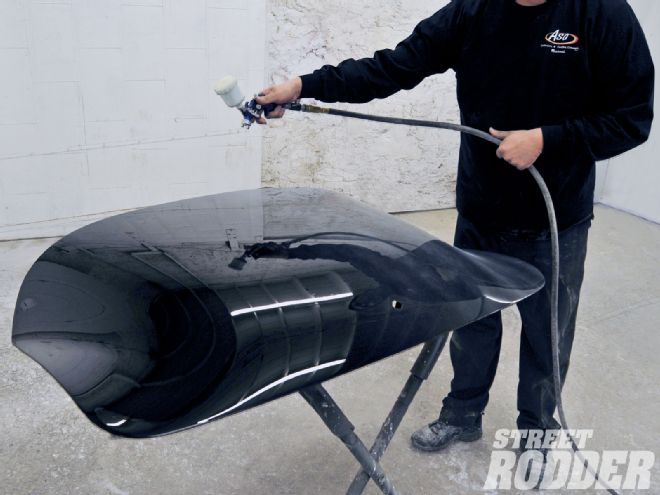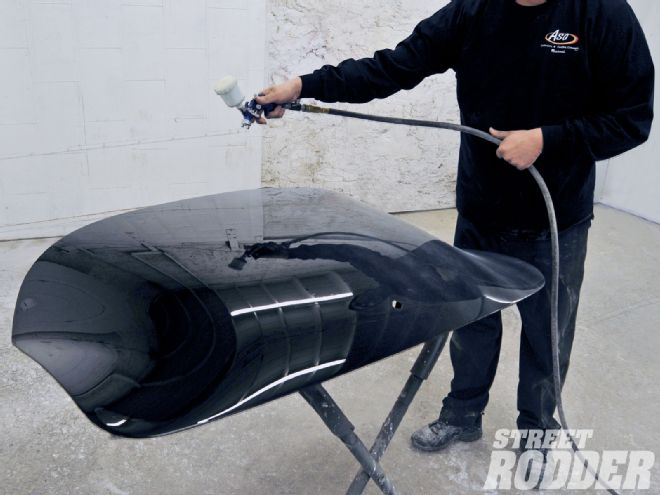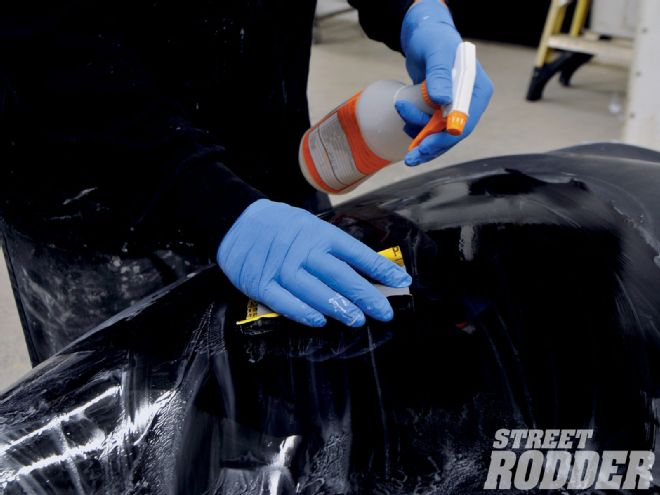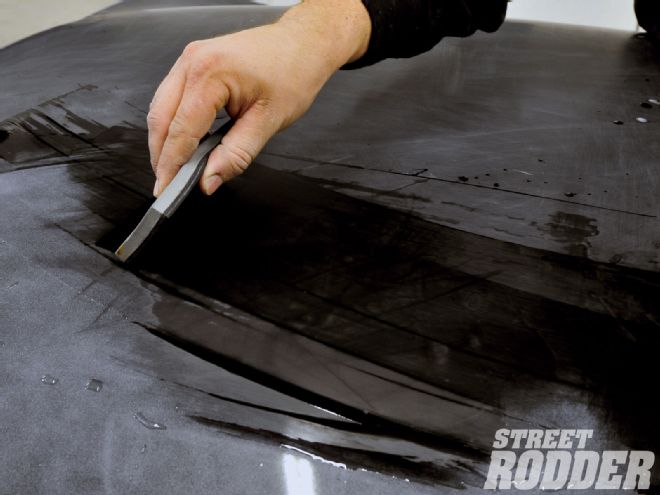
Arguably one of the most important aspects of car building is body and paint. This single aspect of a car makes up 90 percent of its appearance. It not only has the biggest impact on a person when they first see the car, but it is also one of the things people will still be talking about after they are done looking at it. After all, so much can be said about the quality of a car just based on the body and paint. A super-straight, high-gloss paintjob with incredible depth shows just how much patience and time was spent getting the car to that level. Plus, if the body and paint is that good, the same can probably be said for the rest of the car.
 The guys at Asa Custom Concepts have already bodyworked, painted, and applied just two coats of clear to the trunk lid. Once the clear was given plenty of time to cure in an area with plenty of air movement, a dusting of white guidecoat was sprayed on the trunk lid.
The guys at Asa Custom Concepts have already bodyworked, painted, and applied just two coats of clear to the trunk lid. Once the clear was given plenty of time to cure in an area with plenty of air movement, a dusting of white guidecoat was sprayed on the trunk lid.
If you don't believe that body and paint is that important, think of how many times you have looked at a car and thought, "I can't believe how straight it is and how deep the paint is." Chances are if you've ever been to a car show of any kind, you have uttered some form of that phrase a time or two. Then of course, that statement is usually followed with a question, "How did they do that?" You know you're doing the same steps they are, but you're ending up with different results. After all, you've block sanded for hours on your car and it's straight, but not that straight. Not to mention your paint. It shines and has a deep reflective finish, but it's nothing like that.
Well, just like everything associated with car building, body and paint is hard work. Especially if your goal is to make the car as straight as possible and the paint as deep as the eye can see. Just the thought of having to do body and paint scares a lot of hobbyists from doing the work themselves. Plus it is recommended that most of today's paint be sprayed in the controlled environment of a paint booth, which is something the average hobbyist doesn't have.
 The sanding begins by using a soft block and P800-grit sandpaper (the P signifies European grit, which is a little more coarse than 800). A spray bottle filled with water is used to continually saturate the surface for lubrication and to keep the surface clean. Some people use a bucket and a sponge, but the water gets contaminated with that method.
The sanding begins by using a soft block and P800-grit sandpaper (the P signifies European grit, which is a little more coarse than 800). A spray bottle filled with water is used to continually saturate the surface for lubrication and to keep the surface clean. Some people use a bucket and a sponge, but the water gets contaminated with that method.
Nevertheless, there are still a lot of award-winning paintjobs coming out of less than desirable environments that are not paint booths. It is all about choosing the right products for your environment. This is something that can easily be determined by your local paint jobber. However, the paint materials you use are only part of the equation. The bodywork underneath is just as important, if not more important, than the paint itself. Luckily, there are a number of products that can help in this area too.
The truth is, a show car finish isn't as unobtainable as you may think. Not to mention that if you use the right materials it can make the job seem not so hard. To learn more about the subject, we turned to Mike Hilyard and Brian Grubb at Asa Custom Concepts for some insight on getting that impressive show car finish. Between the two of them there is almost 40 years of experience in body and paint, and incredible finishes are just one of their specialties.
Asa Custom Concepts uses a number of products from Spies Hecker to obtain that elusive ultra-straight, ultra-deep show car finish. For those unfamiliar with Spies Hecker paint products, it is a true European finish and is also a division of DuPont Automotive Finishes. Asa Custom Concepts found that this system works the best for their environment and gives them the desired results.
 Brian continually squeegees the surface; this way he doesn't risk the chance of sanding through the clear. It's also very important that the entire guidecoat is sanded off before another coat of clear is put on it. If not, the guidecoat remnants will be permanent under the clear.
Brian continually squeegees the surface; this way he doesn't risk the chance of sanding through the clear. It's also very important that the entire guidecoat is sanded off before another coat of clear is put on it. If not, the guidecoat remnants will be permanent under the clear.
Since a whole book could be written just on bodywork, Asa pointed out that a lot of problems incurred with the paint not being flat and deep enough is related to the clear and how it is applied and buffed out. If you are starting with a good, straight panel, the application of too much clear or insufficient color sanding and buffing can create an orange peel finish no matter how straight the panel is.
In order to best explain how they get "the look", they allowed us to document them step by step as they cleared and polished out the paint on the trunk lid of a '51 Chevy Sedanette. Although it is just one panel of the car, the same concepts can be applied to the rest of the body. Even though it is difficult to explain everything that goes into body and paintwork, this should give you a basic guideline for what it takes to get that incredible show car finish.